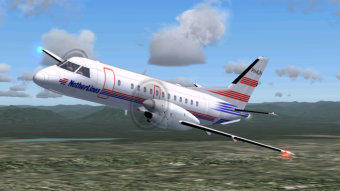various civil
Type
: Stearman Hammond Y-1S
Program
: FS2004 and FSX, pack with 2 repaints
Model
: rarewings.com
Operator
: KLM
Download
: Complete aircraft
In 1937 KLM was interested in the new Douglas DC4E for its Dutch Eastindies-line. The DC4E was developed on the basis of the requirements of the US airlines United, TWA,
Eastern and Pan American. KLM pilot Parmentier has flown the prototype flew and was impressed. KLM was intended to purchase 6 aircrafts with a option for 6 more.
The DC-4E had a nose wheel, while KLM had only aircraft with a tail wheel in its fleet. In order to train their pilots to get used to the nose wheel configuration KLM purchased the
Stearman Hammond Y-1S in September 1937 for training purposes. The Stearman Hammond Model Y was designed by Dean B. Hammond for the Bureau of Air Commerce safe
airplane competition in 1934. Starting point was to develop a simple and reliable aircraft for $ 700, - Model Y was one of the winners and Hammond got orders for 25 planes.
However the prototype did not meet the requirements.Lloyd Stearman was asked to re- engineer the plane to improve performance and general workmanship. Resulting aircraft,
Model Y-1S. Only 20 aircraft have been built.
The prototype of the Douglas DC-4E was tested by United on its routes and was found to be far from economically.The American Airlines placed no orders orders and the project
was canceled.Therefore the Stearman Hammond Y-1S was no longer necessary at KLM.The plane went to the RAE(Royal Aircraft Establishment) at Farnborough
and thoroughly tested.It went to the RAF for assessment. Its ground handling was discribed as "impressive"but it was found impossible to fly an accurate compass course and it
was extremely noisy. The RAF for saw little use for the machine.It remained at the RAE till it was scraped in 1942. Thanks to John Blackburn who sent me a black/white photograph
on which I based the repaint.
Douglas developed during WWII a completely new DC-4 (C-54) which, due to the war, was put into operation by the airlines after 1945.

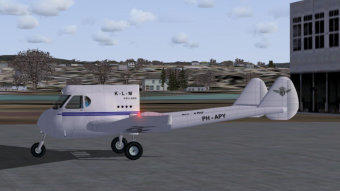
Type
: Scottish Aviation Twin Pioneer
Program
: FS2004 and FSX
Model
: Mike Stone
Operator
: Kroonduif
Download
: Complete aircraft
Kroonduif or Nederlands Nieuw-Guinea Luchtvaart Maatschappij (NNGLM) was a subsidiary of KLM Royal
Dutch Airlines. Established in 1957. It mainly runs till the end of 1962 air routes inside Dutch New Guinea.
Beside 4 C-47's it had 4 De Havilland DHC-2 Beavers and Scottish Aviation Twin Pioneers in its fleet.
The Twin Pioneer had excellent STOL-performances and suitable to operate under extreme conditions.
After the transfer of the territory of New Guinea to Indonesia the fleet became beside one C-47, part of Garuda
Indonesia.


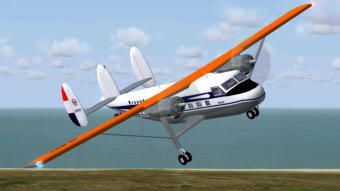

Type
: Canadair CL-44D
Program
: FS2004 and FSX
Model
: Mike Stone
Operator
: Limburg Aircargo
Download
: Complete aircraft
Limburg Aircargo was a subsidiary of Limburg Airlines. The parent company was only active from 15th of June
1973 till 26th of April 1974 from Maastricht-London Gatwick with two Fokker F.27-200's. One did not succeed to
get the passengerservices profitable and to obtain more destinations and it went broke. Limburg Airlines had a
lucrative contract for freightservices to the Far East. To perform this contract one established Limburg Aircargo
and hired from Trans Meridian Aircargo. the Canadair CL-44D G-AZIN from December 1975 till August 1976.
The contract was not renewed and Limburg Aircargo went into liquidation and the G-AZIN went back to the UK.

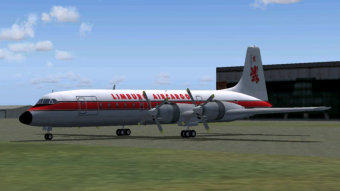
Type
: Ilyushin IL-62
Program
: FS2004 and FSX
Model
: Stepan Gritsevsky en Michael Ackermann
Operator
: Aeroflot/KLM
Download
: Complete aircraft
During the Cold War Western Airliners were not allowed to fly across Russian territory. To solve this problem
KLM wet-leased two IL-62's including crew in 1971.The cabine crew was mixed KLM/Aeroflot.

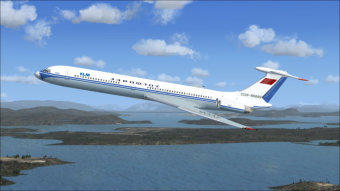


Type
: Bombardier CRJ 200
Program
: FS2004 and FSX
Model
: Premier Aircraft Design
Operator
: Maastricht Airlines
Download
: Complete aircraft
Maastricht Airlines,the airline that never flew. Initially, it looked good. Sufficient initial capital, leased aircraft
already registered in the Dutch aviation register and already a few thousand tickets sold. Operations were
scheduled to begin on 25 March 2013 from Maastricht Aachen Airport to Berlin, Munich and Amsterdam. Due to
corrosion problems the delivery of the Fokker 50 was postponed a few times and even cancelled. No alternative
F50 were available and there was no money left. In June 2013 it was declared bankrupt. It has tried to make a
new start with two Bombardier CRJ 200 but this attempt did not succeed.
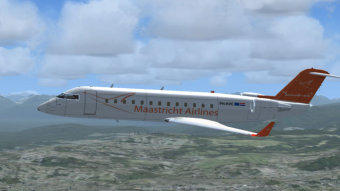

Type
: GAF N-24 Nomad
Program
: FS2004 and FSX, pack with 2 repaints
Model
: AI model Mike Cronin
Operator
: Holland Aero Lines
Downld
: Complete aircraft
Holland Aerolines operated schedulded passenger services from Rotterdam Airport from March 1986 untill December 1987. From 1982 it was already active with charter and
packetservices, using a single GAF N-24 Nomad and a few Piper PA-31 Navajo's. On the scheduled passenger services two GAF N-24 Nomad's and three ATR 42's were used.
They were mainly used on the routes to Southend and Norwich the Nomad's were used and to Orly and Charles de Gaulle, Paris and to Hamburg and Frankfurt the ATR-42's.
The Nomad's were a surprising choice. Holland Aero Lines was the only airline that flew this type in Europe. They were bought for a low price in the USA. The maintenance was
difficult and therefore relatively expensive. One of the Nomad's wass used for spare parts. At the end of 1987 the airline came in serious financial problems and it went bankrupt
soon. The PH-HAG had been in its fleet from 1984 till 1987 and the PH-HAL during 1986.


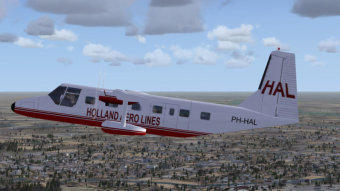
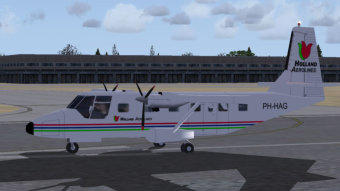
Type
: Pilatus Porter PC-6
Program
: FS2004 and FSX
Model
: Don Moser
Operator
: KLM Aerocarto
Download
: Complete aircraft
The Pilatus Porter is one of the most unique planes in the air. Originally introduced in 1959, she has been used
in war, for police work, rescue, agriculture, bush flying, and many other positions where flexibility is required.
The Porter is a STOL aircraft, and has the ability to go into reverse thrust at altitude to lose altitude very
quickly. The plane can almost beat a skydiver down!
Since 1924 KLM did already aerial photography and air cartering. Initially it used a Fokker CII, the Fokker
F.VIIa and the Fokker F.VIII. After WW2 it restarted this services and bought one Auster MkV from the
warsurplus of the RAF. Later all kinds of types were added, especially Cessna’s and Pipers. Often it hired
additional capacity from third parties.In 1995 the company was sold to the Dutch Heidemij. The PH-OTE flew
from 1969 till 1976 with KLM Aerocarto. Sold to the USA
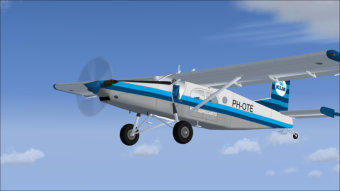


Type
: Vickers Viscount 802
Program
: FS2004 and FSX
Model
: Jens B. Kristensen
Operator
: Dutch Air Ferries
Download
: Complete aircraft
In September 1987 Dutch Air Ferries started a scheduled service Twente Airport(Enschede/Eelde Airport(Groningen) to London Gatwick. Dutch Air Ferries was established by
H. Glastra. He brought 1 million Dutch guilders of the initial capital of 2 million. At the start Dutch Air Ferries had only a few employees on a contract basis and no aircraft of its
own. A Viscount of British Air Ferries was hired. After a few weeks, the services had already to stop due to lack of passengers interest and financial problems.
This repaint is an impression of the livery if DAF would have been succesful. The basic colors of British Air Ferries with the name replaced by Dutch Air Ferries and the other
one based on the DAF time table.
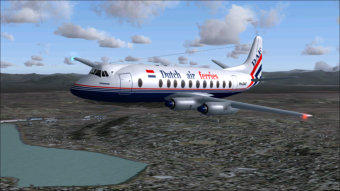
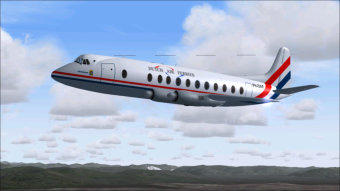
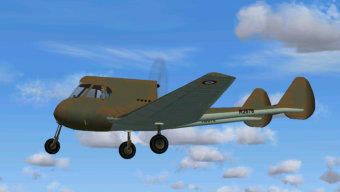


Type
: Vickers Viscount 803
Program
: FS2004 and FSX, with 3 repaints
Model
: Jens B. Kristensen
Operator
: KLM
Download
: Complete aircraft
The Brabazon Committee was established in 1942 with the aim of identifying the needs of the post-war British civilian market. One of the specifications was a design for an
aircraft with a pressurized cabin that could carry 24 passengers over 1,750 miles with a speed of 200 miles per hour. The Vickers Viscount was Vickers-Armstrong's proposal.
Revolutionary was the choice for the newly developed Rolls Royce Dart turboprop. The Committee was not entirely convinced and actually preferred piston engines. In
addition to a prototype for the Viscount, it was decided to order a prototype for the Airspeed Ambassador. The Viscount flew for the first time in 1948. The test flights resulted in
the production series 700 and 800. The last mentioned had an extended fuselage of 1.20 mtr. 445 Viscounts were eventually built by only 23 of the Ambassador. In 1956, KLM
ordered nine of the series 800 and these were delivered from mid-1957 onwards. The PH-VIA was part of the KLM-fleet until 1966 and then sold to Aer Lingus, together with
the other eight.



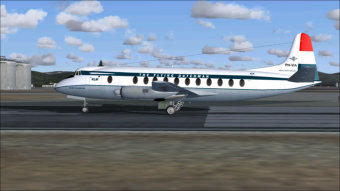

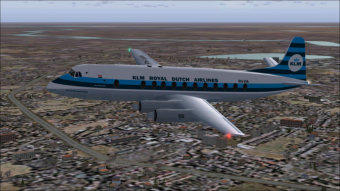
1957
1960
1966

Type
: Junkers Ju-52/3m
Program
: FS2004 and FSX
Model
: Pierino Primavesi
Operator
: Rijksluchtvaartschool
Download
: Complete aircraft
The Rijksluchtvaartschool(Dutch Government Flight Training School)was founded on Januari 1st 1946 on Gilze
Rijen Airforce Base for training pilots for civil aviation. In the same year began the training of airforce pilots on
Gilze Rijen as well and the base became too busy. Therefore the RLS was diverted to Eelde Airport(Groningen).
The RLS started with ex RAF Tiger Moths, Harvards and Beechcrafts D-18S. Soon the Tiger Moths and Harvard
were replaced by SAAB Safirs. In respect with the introduction of jet airliners in the 60's the Dutch Government
ordered in 1962 seven Morane Saulniers MS760B for jettraining.
In June 1946,the Royal Air Force donate 3 Junkers Ju-52 / 3m's to the Rijksluchtvaartschool which came from
the war surplus of the Luftwaffe after the Second World War. The Junkers were mainly used as flying classrooms
until October 1949.The PH-UBA is the former VM985 of the Luftwaffe and was built by the Weser Flugzeugbau.
The Ju 52 / 3m is one of the most produced transport aircraft in history with its 4,845 units. It was produced in
Germany from 1931 to 1945 and after World War II until 1947 at Amiot in France and even until 1952 at CASA in
Spain.

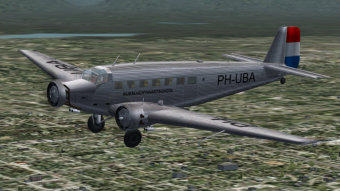


Type
: Saab 340
Program
: FS2004 and FSX
Model
: Mike Stone
Operator
: Netherlines
Download
: Complete aircraft
Netherlines was founded in April 1984 and began services using Jetstream 31’s aircraft and from July 1987
Saab 340 on a route between Amsterdam and Luxembourg. Other cities served throughout the years were
Eindhoven, Enschede, Rotterdam, Groningen, Cologne, Münster, Lille, Birmingham, East Midlands and
Luton. KLM acquired Netherlines in April 1988. In April 1991 the operations of Netherlines were merged with
NLM Cityhopper and became KLM CityHopper. The PH-KJH was one of the three Saab 340's in the
Netherlines-fleet and served from Februari 1989 till Mai 1990.

